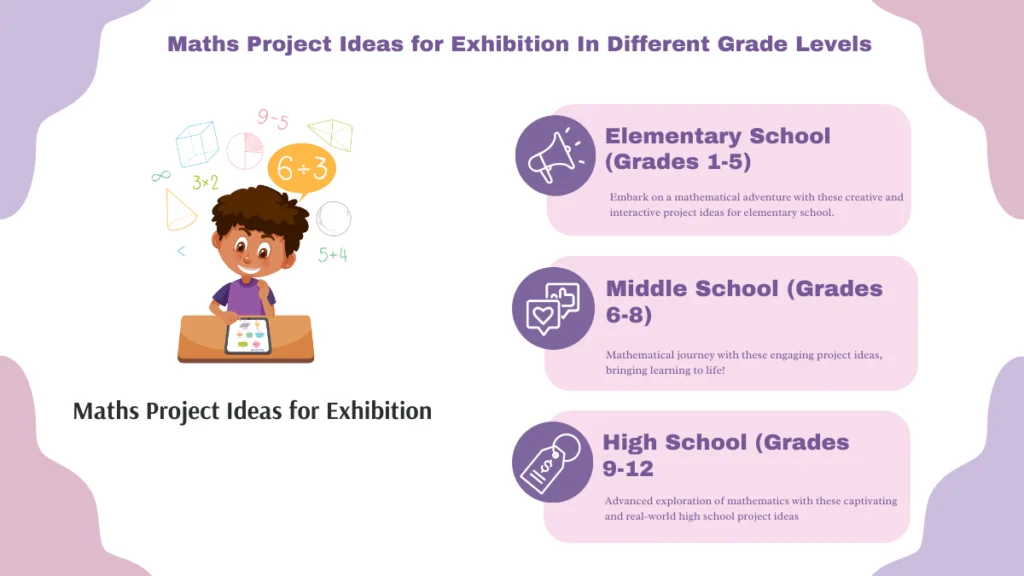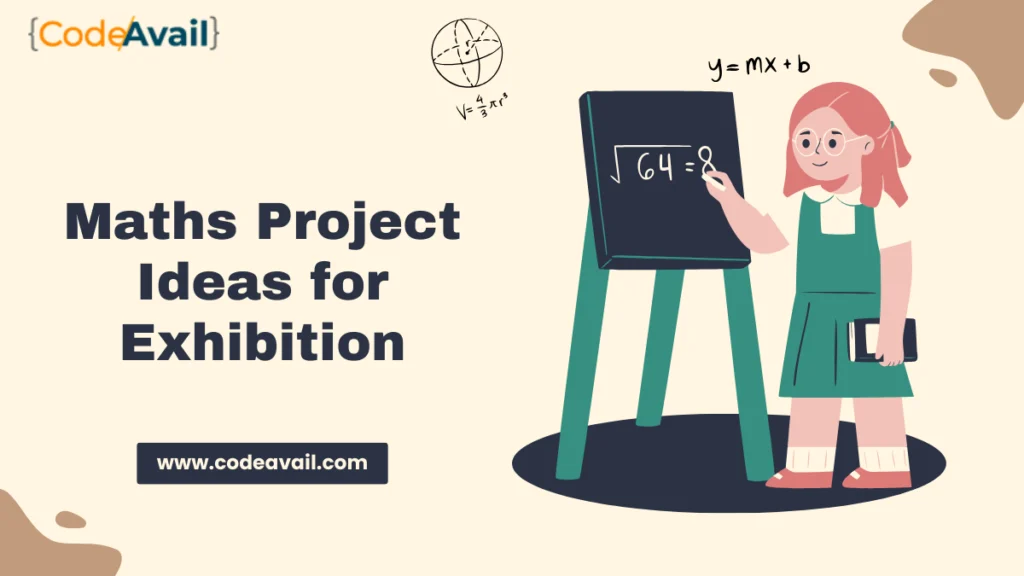Many students find mathematics challenging, but here, we aim to show that it’s not as tough as it seems.
Mathematics is crucial for students as it builds problem-solving skills, logical thinking, and a strong foundation for various careers. Engaging in maths project ideas for exhibition is a fantastic way for students to apply what they’ve learned in a practical and enjoyable manner.
In this blog, we’ll explore the importance of math in everyday life, emphasize its significance for students, and provide many project ideas that make learning math fun and showcase its real-world applications. Get ready to discover the exciting side of mathematics!
What is the Maths Project?
Table of Contents
A Math project is a hands-on and creative way to apply mathematical concepts in real-life scenarios. It involves students designing, implementing, and presenting a tangible representation of mathematical principles.
However, these projects go beyond traditional problem-solving exercises, encouraging students to explore the practical applications of math in various fields. Whether through interactive displays, models, or presentations, math projects enhance understanding, foster critical thinking, and demonstrate the relevance of mathematical concepts in the world.
By engaging in math projects, students strengthen their understanding of mathematical ideas and develop valuable skills such as problem-solving, teamwork, and effective communication.
Importance of Maths Projects in Everyday Life
Mathematics projects play a crucial role in everyday life, contributing to various aspects of our personal and professional activities. Here are several ways in which math projects are important in our daily lives:
- Practical Application: Math projects bridge the gap between theoretical knowledge and real-world application, showing how mathematical concepts are used in everyday life.
- Problem-Solving Skills: Engaging in projects cultivates problem-solving skills as students tackle real challenges, encouraging them to think critically and creatively.
- Hands-On Learning: Math projects provide a hands-on learning experience, allowing students to manipulate numbers, create models, and see the direct impact of mathematical principles.
- Relevance: Demonstrating the relevance of math in daily activities and projects helps students appreciate its importance in budgeting, measurements, and decision-making.
- Interdisciplinary Connections: Math projects often involve collaboration with other subjects, fostering interdisciplinary connections and showcasing the interconnectedness of various fields.
- Communication Skills: Presenting projects hones communication skills as students articulate their ideas, methodologies, and findings, enhancing their ability to express complex concepts clearly.
- Critical Thinking: Students develop critical thinking skills by designing and executing projects, learning to analyze problems and devising effective solutions.
- Career Readiness: The skills acquired in math projects, including problem-solving and communication, are valuable in many careers, preparing students for future success.
Math projects are not only academic exercises but also powerful tools that empower individuals to navigate the complexities of everyday life, make informed decisions, and contribute meaningfully to society.
How to Choose Suitable Math Project Ideas for the Exhibition?
Choosing suitable math project ideas for an exhibition involves considering factors. Here is a step-by-step guide to help you select appropriate math project ideas:
- Identify Interests: Consider students’ interests and passions to make the project engaging and relatable.
- Grade Level Appropriateness: Ensure the complexity of the project aligns with the student’s grade level for an optimal learning experience.
- Real-World Relevance: Choose topics that showcase the real-world applications of math, fostering a deeper understanding of its significance.
- Hands-On Elements: Opt for projects that involve hands-on activities, encouraging active participation and experiential learning.
- Collaboration Potential: Select projects that allow collaboration, promoting teamwork and shared learning experiences.
Top Maths Project Ideas for Exhibition In Different Grade Levels

Here are some math project ideas suitable for different grade levels:
Elementary School (Grades 1-5)
- Math Magic Show (Grades 1-2): Create a magical display where basic arithmetic operations become enchanting tricks, captivating young minds and reinforcing fundamental math concepts.
- Shape Zoo (Grades 3-4): Encourage exploration of geometry by having students design a zoo with animal enclosures shaped as different polygons, integrating learning about shapes and their properties.
- Counting Carnival (Grade 1): Construct a vibrant counting carnival where students showcase their counting skills by arranging objects like balloons, candies, or toys in numerical order.
- Fractional Food Feast (Grades 4-5): Foster understanding of fractions by having students design a menu where various food items represent different fractions, promoting visual learning and fraction comprehension.
- Measurement Masterpieces (Grade 3): Integrate art and math by having students measure and create colorful masterpieces using different units, reinforcing measurement concepts in a creative way.
- Math Puzzles Exhibit (Grades 4-5): Challenge problem-solving skills with a display of handmade math puzzles, encouraging visitors to solve them while enhancing critical thinking and logical reasoning.
- Time Travelers’ Clock Display (Grade 2): Explore the concept of time with a clock display, where students design clocks showing different times and engage visitors in interactive time-telling activities.
- Money Matters Market (Grade 5): Establish a mini-market where students simulate buying and selling, incorporating real-world math skills related to money, budgeting, and making transactions.
Middle School (Grades 6-8)
- Data Detectives (Grade 6): Have students collect and analyze data from their peers, presenting findings through graphs and charts. This project enhances understanding of data representation and interpretation.
- Geometric Dream House (Grade 7): Students design and model their dream houses, incorporating various geometric shapes and calculating the area and perimeter of each room, reinforcing geometry concepts.
- Algebraic Art Gallery (Grade 8): Merge art and algebra by having students create artwork using algebraic equations, showcasing the visual representation of mathematical expressions.
- Probability Carnival (Grade 7): Construct a probability-themed carnival where students design games, calculate the probability of winning and introduce probability concepts in a fun and interactive way.
- Mathematics of Music (Grade 8): Explore the mathematical patterns in music, with students creating musical compositions, understanding rhythm and tempo, and even applying algebra to study musical scales.
- Code Breakers (Grade 6): Introduce coding and logical reasoning by having students create and present their own coded messages, unraveling the mystery of cryptography.
- Architectural Blueprints (Grade 7): Engage in practical applications of scale and proportion by having students design architectural blueprints for a building, considering measurements, ratios, and scale factors.
- Financial Literacy Fair (Grade 8): Create a financial literacy fair where students showcase projects related to budgeting, investing, and understanding interest rates, emphasizing real-world applications of math in personal finance.
High School (Grades 9-12)
- Calculus in Action (Grade 12): Explore real-world applications of calculus by having students investigate and present projects on topics like rates of change, optimization, and integration in various fields such as physics, economics, or biology.
- Statistics and Social Issues (Grade 11): Analyze and present statistical data related to social issues, fostering an understanding of correlation, causation, and the impact of statistics on societal decision-making.
- Trigonometry in Architecture (Grade 10): Explore the role of trigonometry in architecture by having students design and present architectural projects, incorporating concepts like angles, distances, and geometric shapes.
- Mathematics of Cryptocurrencies (Grade 12): Delve into the world of cryptocurrencies, exploring the mathematical principles behind blockchain technology, cryptography, and the algorithms that drive digital currencies.
- Quantum Mathematics (Grade 11): Introduce students to the fascinating intersection of mathematics and quantum physics, exploring concepts like quantum algorithms, quantum cryptography, and the mathematical foundations of quantum mechanics.
- Game Theory Showcase (Grade 10): Investigate and present projects on game theory, exploring its applications in decision-making, economics, and strategic interactions, fostering an understanding of mathematical modeling in real-world scenarios.
- Differential Equations in Biology (Grade 12): Apply differential equations to model biological processes, such as population growth, the spread of diseases, or ecological systems, showcasing the powerful role of mathematics in understanding complex biological phenomena.
- Fractal Art Gallery (Grade 9): Merge art and mathematics by having students create and showcase fractal art, exploring the beauty of self-repeating geometric patterns and the mathematical principles behind fractal generation.
These project ideas can be adapted based on the specific grade level and provide opportunities for students to explore different branches of mathematics while making connections to the real world. Adjust the complexity and depth of the projects to suit the students’ current level of mathematical understanding.
Qualities Of Good Math Projects – Teacher’s Perspective
From a teacher’s point of view, good math projects should possess certain qualities that contribute to the educational and developmental goals of students. Here are some key qualities that make math projects effective and valuable in a classroom setting:
- Relevance: Good math projects should relate to real-world applications, helping students see the practical significance of mathematical concepts.
- Engagement: Projects should capture students’ interest and enthusiasm, fostering a love for learning and making math enjoyable.
- Clarity of Objectives: Clearly defined project objectives enable students to understand the purpose, aligning the project with specific learning goals.
- Creativity: Encourage creativity by allowing students to explore different approaches and solutions, promoting independent thinking.
- Appropriate Complexity: Projects should match the students’ grade level, providing a suitable level of challenge without overwhelming them.
- Interdisciplinary Connections: Integration with other subjects enhances the project’s richness, showcasing the interdisciplinary nature of mathematics.
- Hands-On Exploration: Projects involving hands-on activities promote active learning and reinforce theoretical concepts through practical application.
- Assessment Opportunities: Incorporate clear criteria for assessment, allowing teachers to evaluate students’ understanding and application of mathematical principles effectively.
Closing Up!
The math project ideas for exhibition offer a captivating journey where numbers transform into interactive displays, practical applications, and creative presentations.
These projects serve as a bridge between theoretical concepts and real-world scenarios, making mathematics approachable and enjoyable. From elementary to high school, these ideas reinforce academic understanding and nurture critical thinking, problem-solving, and teamwork skills.
By showcasing the diverse and exciting facets of mathematics, these exhibitions contribute to a broader appreciation of the subject, turning abstract theories into engaging and memorable learning experiences for students of all ages.
Frequently Asked Questions (FAQs)
1. What can we make for the math exhibition?
Various engaging math projects for exhibitions include creating a geometric dream house, designing a probability-themed carnival, exploring the mathematics of music, or even constructing a financial literacy fair. These projects blend learning with creativity, making math concepts visually appealing and relevant.
2. What benefits do math projects for exhibitions offer to students?
Math projects enhance the practical application of concepts, foster critical thinking and problem-solving skills, and provide a platform for creative expression. They also showcase the relevance of mathematics in everyday life and various fields.
3. Can math projects for exhibitions be integrated with other subjects?
Absolutely! Math projects can seamlessly integrate with other subjects, fostering interdisciplinary connections. For instance, combining math with art, science, or technology can provide a more holistic learning experience and showcase the interconnectedness of different fields.


